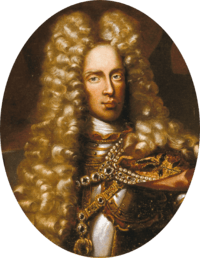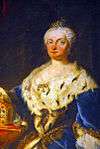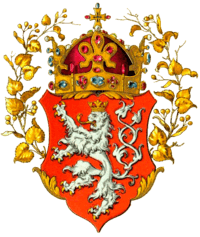Joseph I, Holy Roman Emperor
| Joseph I | |
|---|---|
 | |
| King of Germany | |
| Reign | 23 January 1690 – 17 April 1711 |
| Coronation | 26 January 1690, Augsburg |
| Predecessor | Leopold I |
| Successor | Charles VI |
| King of Hungary | |
| Reign | 9 December 1687 – 17 April 1711 |
| Coronation | 9 December 1687, Pressburg |
| Predecessor | Leopold I |
| Successor | Charles VI |
| King of Bohemia | |
| Reign | 5 May 1705 – 17 April 1711 |
| Predecessor | Leopold I |
| Successor | Charles VI |
| Holy Roman Emperor; Archduke of Austria; King of Croatia | |
| Reign | 5 May 1705 – 17 April 1711 |
| Predecessor | Leopold I |
| Successor | Charles VI |
| Born |
26 July 1678 Vienna, Austria |
| Died |
17 April 1711 (aged 32) Vienna, Austria |
| Burial | Imperial Crypt, Vienna |
| Spouse | Wilhelmine Amalia of Brunswick-Lüneburg |
| Issue |
Maria Josepha, Queen of Poland Archduke Leopold Joseph Maria Amalia, Holy Roman Empress |
| House | House of Habsburg |
| Father | Leopold I, Holy Roman Emperor |
| Mother | Eleonore-Magdalena of Neuburg |
| Religion | Roman Catholicism |
Joseph I (26 July 1678 – 17 April 1711) was Holy Roman Emperor from 1705 until his death in 1711. He was the eldest son of Emperor Leopold I from his third wife, Eleonor Magdalene of Neuburg. Joseph was crowned King of Hungary at the age of nine in 1687, and King in Germany at the age of eleven in 1690. He succeeded to the imperial throne and that of Bohemia when his father died.
Joseph continued the War of the Spanish Succession, begun by his father, against Louis XIV of France, in a fruitless attempt to make his younger brother Charles (later Charles VI, Holy Roman Emperor) King of Spain; in the process, however, owing to the victories won by his military commander, Prince Eugene of Savoy, he did succeed in establishing Austrian hegemony over Italy. Joseph also had to contend with a protracted revolt in Hungary, fomented by Louis XIV. Neither conflict was resolved until after his death.[1]
His motto was Amore et Timore (Latin for "Through Love and Fear").[2]
Early life
Born in Vienna, he was educated strictly by Prince Dietrich Otto von Salm and became a good linguist. Although the first son and child born of his parents' marriage, he was his father's third son and seventh child. Previously, Leopold had been married to Infanta Margaret Theresa of Spain, who had given him four children, one of whom survived infancy. Then, he married Claudia Felicitas of Austria, heiress of Tyrol, who gave him two short-lived daughters. Thus, Joseph had six half-siblings. In 1684, the six-year-old Archduke had his first portrait painted by Benjamin von Block. At the age of nine, on 9 December 1687, he was crowned King of Hungary; and at the age of eleven, on 23 January 1690, King of the Romans. Unlike many of his relatives, although a Roman Catholic, Joseph was not one for religion. The cause of this may be that he was spared a strict religious upbringing.[3] He had two great enthusiasms: music and hunting.[3]
Military service

In 1702, at the outbreak of the War of the Spanish Succession, Joseph saw his only military service. He joined the Imperial General, Louis William, Margrave of Baden-Baden, in the Siege of Landau.
Holy Roman Emperor
Prior to his ascension, Joseph had surrounded himself with reform-hungry advisors and the ‘young court’ of Vienna was ambitious in the elaboration of innovative plans. He was described as a "forward-looking ruler".[3] The large number of privy councillors was reduced and attempts were made to make the bureaucracy more efficient. Measures were taken to modernize the central bodies and a certain success was achieved in stabilizing the chronic Habsburg finances. Joseph also endeavoured to strengthen his position in the Holy Roman Empire – as a means of strengthening Austria’s standing as a great power. When he sought to lay claim to imperial rights in Italy and gain territories for the Habsburgs, he even risked a military conflict with the Pope over the duchy of Mantua.[3]
In Hungary, Joseph had inherited the kuruc rebellion from his father Leopold I: once again, nobles in Transylvania (Siebenbürgen) had risen against Habsburg rule, even advancing for a time as far as Vienna. Although Joseph was compelled to take military action, he refrained – unlike his predecessors – from seeking to teach his subjects a lesson by executing the leaders. Instead, he agreed to a compromise peace, which in the long term facilitated the integration of Hungary into the Habsburg domains.[3] It was his good fortune to govern the Austrian dominions and to be head of the Empire, during the years in which his trusted general, Prince Eugene of Savoy, either acting alone in Italy or with the Duke of Marlborough in Germany and Flanders, was beating the armies of Louis XIV of France. During the whole of his reign, Hungary was disturbed by the conflict with Francis Rákóczi II, who eventually took refuge in the Ottoman Empire. The emperor reversed many of the authoritative measures of his father, thus helping to placate opponents. He began the attempts to settle the question of the Austrian inheritance by a pragmatic sanction, which was continued by his brother Charles VI.
Death
During the smallpox epidemic of 1711, which killed Louis, le Grand Dauphin and three siblings of the future Holy Roman Emperor Francis I, Joseph became infected. He died on 17 April in the Hofburg Palace. He had previously promised his wife to stop having affairs, should he survive.
The Emperor was buried with great fast in the Imperial Crypt, resting place of the majority of Habsburgs. His funeral took place of 20 April that same year. He is buried in tomb no. 35 in Karl's Vault. His tomb was designed by Johann Lukas von Hildebrandt and it is decorated with pictures of various battles from the War of Spanish Succession. Josefstadt (the eighth district of Vienna) is named for him.
Marriage and lack of heir(s)
On 24 February 1699, he married Wilhelmine Amalia of Brunswick-Lüneburg in Vienna. She was a descendant of two Holy Roman Emperors, Frederick II and Louis IV; and also of William I, Prince of Orange and James VI of Scotland and I of England. They had three children and their only son died of hydrocephalus before his first birthday. Joseph had a passion for love affairs (none of which resulted in illegitimate children) and he caught a sexually transmittable disease, probably syphilis, which he passed on to his wife while they were trying to produce a new heir. This incident rendered her sterile and for her to bear an heir was not only unlikely, it was impossible.[3] Their father, who was still alive during these events, made Joseph and his brother Charles sign the Mutual Pact of Succession, ensuring that Joseph's daughters would have absolute precedence over Charles's daughters, neither of whom was born at the time, and that Maria Josepha would ascend both the throne of the Holy Roman Empire and the throne of the Kingdom of Spain.
Issue
| Name | Portrait | Lifespan | Notes |
|---|---|---|---|
| Maria Josepha Queen of Poland |
 |
8 December 1699 – 17 November 1757 |
Archduchess of Austria, married Augustus III, King of Poland and Elector of Saxony. |
| Leopold Joseph |
 |
29 October 1700 – 4 August 1701 |
Archduke of Austria, died in infancy. |
| Maria Amalia Holy Roman Empress |
 |
22 October 1701 – 11 December 1756 |
Archduchess of Austria, married Charles VII, Holy Roman Emperor |
Ancestors
Full title
Joseph I, by the grace of God elected Holy Roman Emperor, forever August, King in Germany, King of Hungary, Bohemia, Dalmatia, Croatia, Slavonia, Rama, Serbia, Galicia, Lodomeria, Cumania and Bulgaria, Archduke of Austria, Duke of Burgundy, Brabant, Styria, Carinthia, Carniola, Margrave of Moravia, Duke of Luxemburg, of the Higher and Lower Silesia, of Württemberg and Teck, Prince of Swabia, Count of Habsburg, Tyrol, Kyburg and Goritia, Marquess of the Holy Roman Empire, Burgovia, the Higher and Lower Lusace, Lord of the Marquisate of Slavonia, of Port Naon and Salines, etc.[4]
References
- ↑ "MSN Encarta". Archived from the original on 2009-10-31.
- ↑ "Joseph I as Roman-German Emperor, oval portrait with motto". The World of the Habsburgs. english.habsburger.net. Retrieved February 18, 2012.
- 1 2 3 4 5 6 "Reforming zeal in the Baroque: Joseph I". The World of the Habsburgs. english.habsburger.net. Retrieved February 18, 2012.
- ↑ His full title was: Joseph I, by the grace of God elected Holy Roman Emperor, forever August, King in Germany, King of Hungary, Bohemia, Dalmatia, Croatia, Slavonia, Rama, Serbia, Galicia, Lodomeria, Cumania and Bulgaria, Archduke of Austria, Duke of Burgundy, Brabant, Styria, Carinthia, Carniola, Margrave of Moravia, Duke of Luxemburg, of the Higher and Lower Silesia, of Württemberg and Teck, Prince of Swabia, Count of Habsburg, Tyrol, Kyburg and Goritia, Marquess of the Holy Roman Empire, Burgovia, the Higher and Lower Lusace, Lord of the Marquisate of Slavonia, of Port Naon and Salines, etc. etc.
 This article incorporates text from a publication now in the public domain: Chisholm, Hugh, ed. (1911). "article name needed". Encyclopædia Britannica (11th ed.). Cambridge University Press.
This article incorporates text from a publication now in the public domain: Chisholm, Hugh, ed. (1911). "article name needed". Encyclopædia Britannica (11th ed.). Cambridge University Press.
Bibliography
- F. Krones von Marchiand, Grundriss der Oesterreichischen Geschichte (1882)
- F. Wagner, Historia Josephi Caesaris (1746)
- J. C. Herchenhahn, Geschichte der Regierung Kaiser Josephs I (1786–1789)
- C. van Noorden, Europäische Geschichte im achtzehnten Jahrhundert (1870–1882).
External links
![]() Media related to Joseph I, Holy Roman Emperor at Wikimedia Commons
Media related to Joseph I, Holy Roman Emperor at Wikimedia Commons
- Joseph I in the German National Library catalogue
- Joseph I.: "Regina coeli"
- Joseph I (Holy Roman Empire) - MSN Encarta (Archived 2009-10-31)
| Joseph I, Holy Roman Emperor Born: 26 July 1678 Died: 17 April 1711 | ||
| Regnal titles | ||
|---|---|---|
| Preceded by Emperor Leopold I |
Holy Roman Emperor King of Bohemia Archduke of Austria Duke of Teschen King of Croatia 1705–1711 |
Succeeded by Emperor Charles VI |
| King in Germany 1690–1711 with Leopold I (1690–1705) | ||
| King of Hungary 1687–1711 with Leopold I (1687–1705) | ||
-


.svg.png)